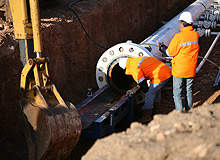
The Medgaz pipeline is a 210km subsea pipeline between Beni Saf in Algeria and Almería in Spain. The 24in diameter pipeline laid under the Mediterranean Sea has the capacity to carry 8 billion cubic metres per year of natural gas.
The new pipeline will help in meeting the growing gas demand in Europe and is considered as a strategic project for Algeria, Spain and Europe. Since the pipeline does not pass through third countries, it increases the security of supply to southern Europe.
An investment of €900m was made in the project. The EU provided a loan of €2m and in November 2010, the European Investment Bank provided a €500m loan for the project.
Technical tests are currently being carried out although no official date of opening has been announced.
Partners
The pipeline was built by Medgaz which is also responsible for operating it. Medgaz was established by Sonatrach (20%) and Cepsa (20%) in 2001. Other stakeholders in Medgaz include Iberdrola, Endesa, BP, Total and Gaz de France Suez who each have a 12% stake.
Pipeline route
The Medgaz pipeline will carry gas from Beni Saf situated on the Algerian coast to a landfall site in Almeria in Spain. In Algeria, the pipeline will be connected to Sonatrach’s Hassi R’Mel-Beni Saf gas pipeline.
In Spain, it will connect with the Almería-Albacete gas pipeline operated by ENAGAS. Connection with the Almería-Albacete gas pipeline will provide a link to the Spanish and European gas grid.
Construction and infrastructure
Construction of the pipeline required exhaustive marine surveys to determine the most suitable route under the Mediterranean Sea. Medgaz used the Odin Finder and Rig Supporter vessels and state-of-the-art mapping technologies to carry out the surveys. Unmanned submarines such as the Hugin 3000 and C-Surveyor I were also deployed during the surveys.
Laying of the pipeline in shallow waters (up to 2,000m) was carried out by Saipem’s pipe laying barge Castoro Sei. The installation commenced in March 2008 using the S-lay method, which involved welding of 12m pipeline sections horizontally and passing them through the barge’s pipe-lay stinger. The pipeline sections form an S-shape from the exit point of the stinger to the seafloor.
Deepwater laying of the pipeline was carried out by the Saipem 7000 vessel using the J-lay method. Installation works commenced in August 2008. The technique involved welding of 50m-long sections of the pipeline, which leave the vessel from a vertical ramp and reach the seabed, forming a J-shape.
The project also included construction of a compressor station in Algeria and a receiving terminal in Almería. The compressor station is spread over an area of 150,000m². It will increase the pressure of the gas coming from the Hassi R’Mel fields for transfer to Spain. The Almeria receiving terminal will regulate and measure the natural gas received from Beni Saf and will transport it to the Spanish gas grid.
Contracts
Intec Engineering carried out the front end engineering and design (FEED) study for the pipeline. Ramboll, in collaboration with Intec, carried out the FEED study for the compressor station at Algeria.
Geoconsult was contracted to carry out a detailed route survey for the pipeline in April 2004. C&C Technologies was responsible for carrying out the marine survey.
Japan-based Mitsui and Sumitomo supplied 90,000t of high-strength carbon steel for the pipeline. The pipes were coated with three layers of propylene and one layer of concrete for corrosion resistance.
In February 2007, Rolls-Royce was awarded a contract to supply three 44,000hp gas compressors for the compressor station in Algeria. The compressors are powered by aero-derivative gas turbines.
Saipem was awarded the turnkey contract for subsea installation of the pipeline in April 2007. The scope of work for Saipem included detailed engineering, pipeline laying and testing.
The Técnicas Reunidas-Amec Spie consortium was awarded the contract to build the compressor station at Algeria and receiving terminal in Almería.
In June 2007, Dresser-Rand was awarded a contract to supply three DATUM compressor trains for the project.
In May 2009, Radyne supplied two 450kW induction power modules to be installed on the Castoro Sei vessel.
James Walker Iberica supplied its FR25/90 valves for the pipeline. Canusa-CPS provided weld joint corrosion protective coatings for the field joints of the pipeline.
Lloyd’s Register was contracted to provide inspection and certification services.



